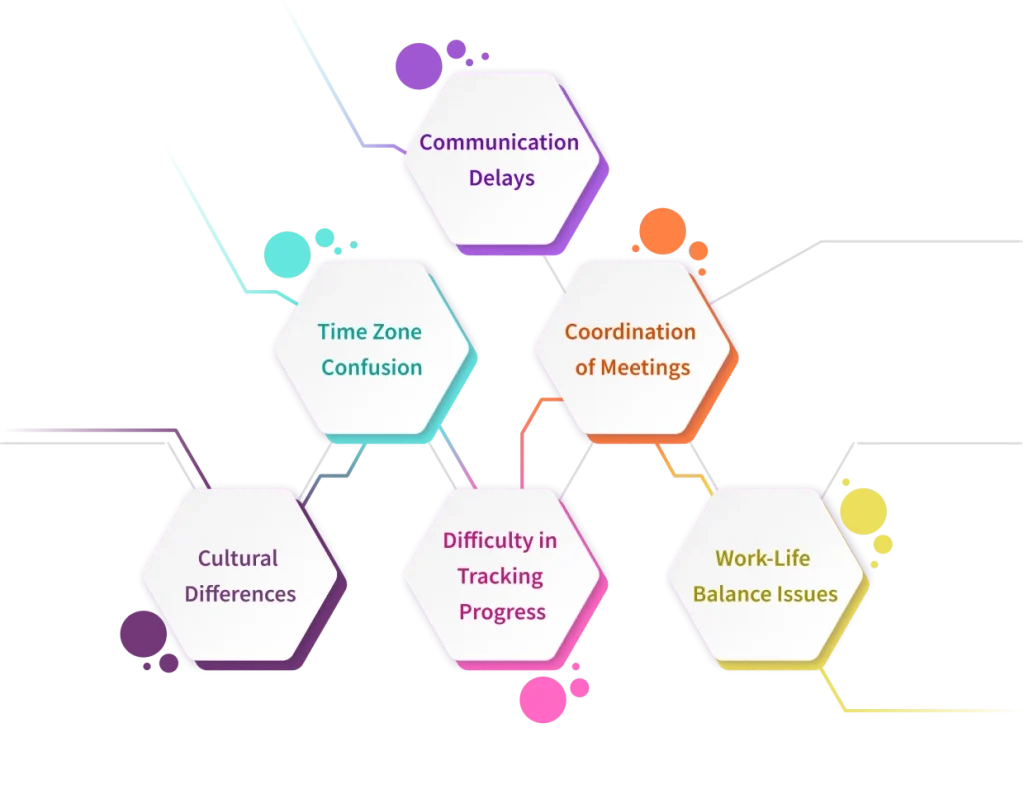Have you ever experienced the challenges of how to manage remote teams across different time zones? It’s hard to coordinate schedules, handle delays, or keep everyone aligned. These things can make projects take too long to get done and make team members feel disconnected.
The solution? You can build a powerful and efficient team if you have the right tools and simple strategies. In this blog, you will learn how to manage remote teams effectively even when they are in different time zones. Let’s dive in!
Challenges of Managing Distributed Teams Across Different Time Zones
Managing distributed teams working from various time zones is hard and coming up with challenges makes work harder. Understanding these challenges is important for teams to work smoothly and stay connected.

1. Communication Delays
Sometimes the communication delay happens when your teammates are located in various time zones. People work at different times, so messages take longer to get responses. When you send a message, they might be asleep or unavailable because of the time zone differences. Urgent issues can remain unsolved for hours. It slows down decision-making and project progress.
2. Coordination of Meetings
Planning meetings across time zones is a challenge. Some team members join at odd times, like a little bit too early in the morning or too late at night. It leads to work fatigue and lower focus during conversations. You also have fewer options for scheduling meetings that everyone can attend. These obstacles make teamwork difficult and slow progress.
3. Time Zone Confusion
Tracking time differences across locations is difficult. You can’t remember everyone’s working hours, especially in teams that are dispersed across several zones. There is a chance that you might schedule meetings or tasks for other people at the wrong time. As a result, this can result in delays and inconveniences with meeting deadlines.
4. Cultural Differences
Differences in culture can lead to misunderstandings in a distributed team. Each team member may have a different style of communication and expectations. It also leads to confusion about how tasks should be tackled. Some prefer direct communication and others want a more respectful approach. It is more difficult to collaborate effectively because of these differences.
5. Difficulty in Tracking Progress
Tracking progress is hard when you manage remote teams. It’s very difficult to get real-time updates because of different time zones. Team members have different work hours; hence they might have communication gaps. This will slow down the ability to monitor tasks and milestones. It is hard to make sure everyone is on the same page.
6. Work-Life Balance Issues
When your employees are working remotely across different locations and various time zones, it can be difficult for them to maintain a good balance between work and life. Different time zones may make work hours longer, and decrease personal time for the employees. Over time makes it harder to set boundaries between professional and personal life. It can cause stress and poor well-being.
Overcome the challenges of managing remote teams with Time Champ!
Start your free trial now and unlock your remote team's full potential!
Signup for FreeBook DemoHow to Manage a Remote Team Working Across Different Time Zones
Here are some simple tips to manage your remote teams who are working across various time zones effectively.
1. Set Clear Expectations and Goals
When managing remote teams, you need to make your project goals and requirements crystal clear. Create simple project outlines that explain what needs to be done, when it’s due, and who’s responsible for each task. Make sure these instructions are easy to understand for team members working in any time zone.
Set up a straightforward way to track progress that everyone can check, no matter when they’re working. Use tools that show deadlines in each person’s local time zone and let team members easily update their progress. This helps everyone stay on the same page and understand exactly what they need to do.
Create simple rules for how your team should communicate. Set up standard ways to share updates, ask questions, and report problems. This makes it easier for everyone to understand and share information, even when working at different times.
2. Encourage Team-Building Activities
Plan regular online activities that help your team members get to know each other better. This could be virtual coffee breaks, casual chat sessions, or online team games. Schedule these at different times so everyone can join in, regardless of their time zone.
Mix up the types of activities you offer so team members can participate in ways that work for them. Some might prefer group video calls, while others might enjoy ongoing chat discussions or collaborative projects they can work on at their own pace.
Give your team chances to learn about each other’s backgrounds and cultures. Let team members share stories about their local traditions, holidays, or ways of working. This helps everyone understand and appreciate their differences.
3. Foster a Culture of Accountability
Make sure everyone knows exactly what they’re responsible for and when their work is due, reinforcing employee accountability. Create a simple system that shows who’s in charge of each task and how team members should report their progress. Include clear steps for what to do when problems come up.
Build trust by keeping communication open and honest. Have regular check-ins where team members can share updates and concerns in a way that fits their schedule. Make these meetings about both work progress and how team members are feeling.
Create ways for your team to give feedback and raise concerns safely. This could be through private conversations, team meetings, or anonymous suggestions. Keep your team informed about decisions and changes, and explain the reasons behind them.
4. Provide Training on Remote Work Tools
Choose simple, effective remote tools that help your team work together. Pick tools that work well for communication, sharing files, and tracking projects. Make sure these tools are easy to use together and work well for people in different time zones.
Set up a clear way for team members to get help with technical problems, no matter when they’re working. Have guides ready for common issues and make it clear who to contact for extra help. Check regularly to see if any tools are causing problems.
Ask your team how the tools are working for them. Use simple surveys to understand what’s working well and what needs to be better. Make changes based on what you learn to keep your remote work setup running smoothly.
5. Continuously Gather Feedback and Improve
Regularly ask your team how things are going. Use simple surveys and conversations to learn what’s working and what needs to change. Make sure everyone can share their thoughts, regardless of where or when they work.
Look at the feedback you get and make a plan to address it. Group similar suggestions together and focus on changes that will help the most people. Keep your team updated on how you’re using their feedback.
When you make changes based on feedback, clearly explain what’s changing and why. Tell your team when changes will happen and how it will affect their work. Make sure everyone has the support they need to adapt to new ways of doing things.
Best Practices to Manage Teams Working Remotely Across Time Zones
Remote team management in various time zones requires work and good communication. What you should concentrate on is setting clear schedules and using the appropriate tools that help your team stay connected. Being flexible and understanding helps your team work well together. There are simple strategies that can increase teamwork and productivity. Here are some of the managing remote teams best practices.
1. Establish Clear Working Hours
You should set working hours clearly for your team to help avoid confusion. They should know when they should be online. Pay attention to time zone differences and create a schedule that is OK for all of them. Create one common document in which everyone shares their working hours. It will help everyone plan their tasks better.
2. Use Asynchronous Communication
You should encourage communication that doesn’t require instant replies. To share information you can use emails, shared documents, or message boards. It enables team members to answer when they are available. It decreases their stress and increases work quality. Teamwork is made easier with asynchronous communication.
3. Schedule Regular Check-Ins
Regular check-ins help you keep your team in sync and updated. Have quick calls to learn how their work is going and what problems might slow them down. Select a time that most team members are available. The goal is to keep meetings short and on track. This helps build trust as well as build teamwork.
4. Utilize Time-Zone and Project Management Tools
The right tools help you manage remote teams at different time zones. Time zone management and project tracking tools can help you get better results. These tools help you simply assign tasks and set deadlines. They also tell you when team members are available and when not available. This makes the teamwork organized.
5. Be Flexible and Empathetic
Flexibility makes remote work easier for everyone. Think about when your team members live in other time zones or have things to take care of at home. Let them work when it fits their life best. When they tell you about what they need, you can listen and care. When you help your team this way, they will do better work and feel better too.
Ready to master remote team management?
Try Time Champ now for seamless remote team management!
Signup for FreeBook DemoManage Remote Teams Effectively Using Time Champ
Remote team management is not easy because of the visibility, tracking of attendance, and productivity issues. Time Champ is the best employee time and productivity tracking software that offers comprehensive features to solve these problems and helps in managing remote teams.
1. Real-time attendance Tracking
If your team is spread across time zones, it’s hard to know when they are starting and ending their work. Time Champ tracks time automatically based on employees’ local time zones. It gives accurate clock-ins, breaks, and clock-outs to know exactly how long people worked.
2. Productivity Tracking Across Time Zones
It’s difficult to monitor productivity when team members work at different hours. Time Champ can track employee’s activities in real-time and give you insights into their work habits, regardless of their time zone. If your employees are not performing their best, you can analyze when they are the most productive, and when they are nonproductive, and adjust work schedules to increase the productivity of the team.
3. Automated Work Reports
Dealing with all the work updates from multiple locations in different time zones causes communication gaps and time delays. Time Champ automatically generates daily or weekly reports to tell you how many tasks were completed, how many hours employees worked, and overall productivity. You can stay updated without having to constantly check in across different time zones all over the world using Time Champ.
4. Project Management & Progress Tracking
Working with other people from different time zones can easily result in delays and confusion. Time Champ gives you the flexibility to assign projects and tasks, and set deadlines easily. You can also track work progress and budgets easily. No matter where your team is located, regardless, you can monitor who is working on what and make sure projects and tasks are completed on time.
5. Time Zone Management
When you are in multiple time zones, dealing with scheduling meetings or deadlines can be difficult. Time Champ allows you to schedule tasks and meetings based on employees’ time zones. It ensures workload distribution sufficiently and avoids burnout from working simultaneously for multiple tasks.
6. Automatic Timesheets
Keeping track of work hours as well as maintaining the records honestly can be tough for remote teams. Time Champ keeps track of the employees’ time they are spending on tasks and projects accurately with its automatic timesheet feature. Managers could check in and approve or reject timesheets quickly. Automatic timesheets save your time and provide accuracy with clear records for payroll and client billing.
Take control of remote team management across time zones using Time Champ!
Boost productivity and streamline collaboration. Start your free trial now and see the difference!
Signup for FreeBook DemoConclusion
It might sound like it should be tough to manage remote teams that are spread across different time zones, but with the right tools and strategies you can overcome these challenges. You need to create a set of clear goals, great teamwork, and the smart usage of the technologies to make a productive and happy team. Listen to what your team needs to stay flexible, and then improve your processes. No matter where your remote team is, with consistent effort, they can thrive.
Frequently Asked Questions
Trust grows when you focus on outcomes rather than micromanaging tasks. Set clear goals, provide autonomy, and celebrate achievements. Regularly communicate with your team to stay updated and encourage transparency in sharing challenges and progress.
Conflicts should be addressed promptly and professionally. Schedule a private one-on-one video call with the individuals involved to understand their perspectives. Encourage open and respectful dialogue. Work together to find a solution and follow up to ensure the issue is resolved.
Use project management tools such as Time Champ to track tasks and deadlines. Regularly review each team member’s workload and adjust assignments as needed. Encourage your team to communicate if they feel overburdened. Scheduling regular check-ins can help you monitor and maintain balance.
Effective remote team management can lead to higher productivity, access to a global talent pool, improved employee satisfaction, and cost savings on office expenses. Over time, it also fosters a culture of trust, flexibility, and collaboration, which strengthens the team and enhances overall performance.
Set clear performance metrics that align with individual roles. Use data from project management tools and regular check-ins to evaluate their contributions. Provide constructive feedback and focus on their growth and development. Schedule performance reviews at a time convenient for both parties, considering time zones.






